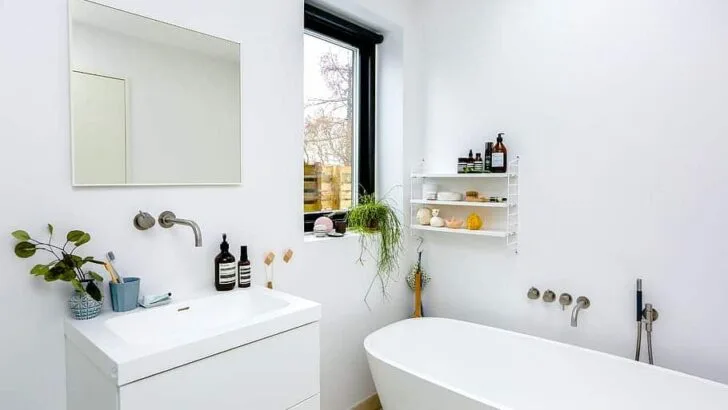You are looking into decorating your bathroom with plants, but you don’t know which varieties will thrive. In this article, I will discuss the best houseplants for your bathroom.
Bathrooms and Plants
An essential thing about bathrooms is that not every bathroom is the same. There are small and big bathrooms. Some with windows and others without. Some might be used multiple times daily, while guest bathrooms might remain unused, cold, and dry for extended periods.
All these different characteristics will impact which plants will grow well in a specific bathroom.
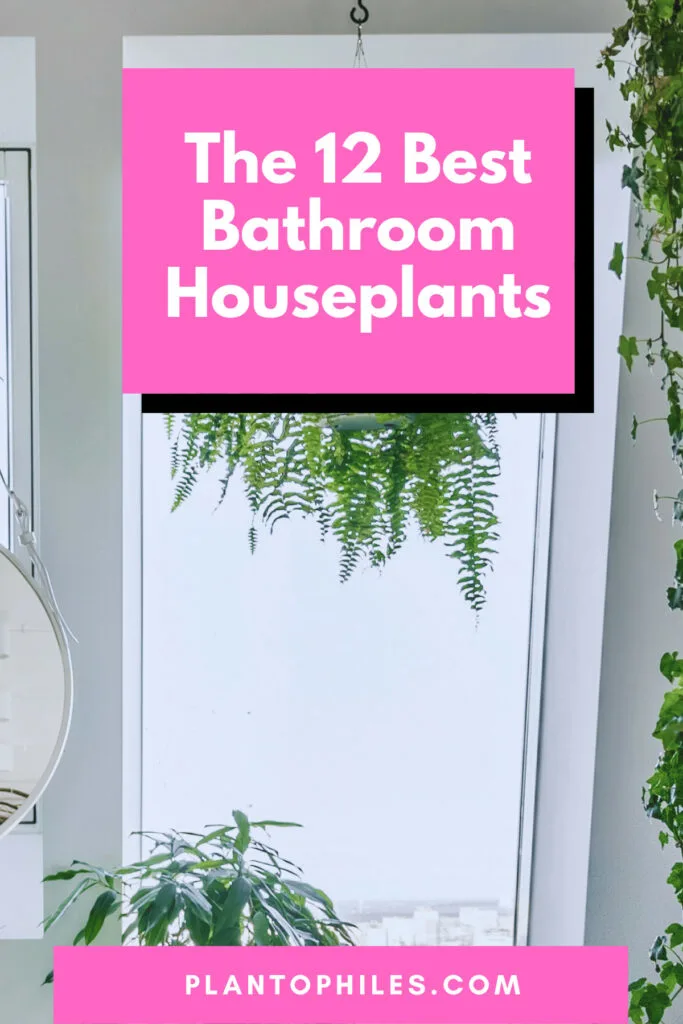
The positive aspects of keeping houseplants in bathrooms are undisputed. Houseplants can help create a calm and relaxing atmosphere and decorate spaces in a nice and natural way.
Besides adding green or color to your bathroom, the bathroom can also benefit the plants and be an optimal environment.
In general, bathrooms are often warmer than the rest of the house and more humid as there is water flowing and steaming almost, if not every day.
The biggest caveat of many bathrooms is often the lack of light in case no window is present. In addition, bathrooms are often making use of milk glass so nobody can peek in.
If we translate this into houseplant language, houseplants must be fine with indirect to very little light. With no windows, they have to be fine with artificial light only.
Table of Contents
The 12 Easiest Houseplants for Your Bathroom
1. Bamboo
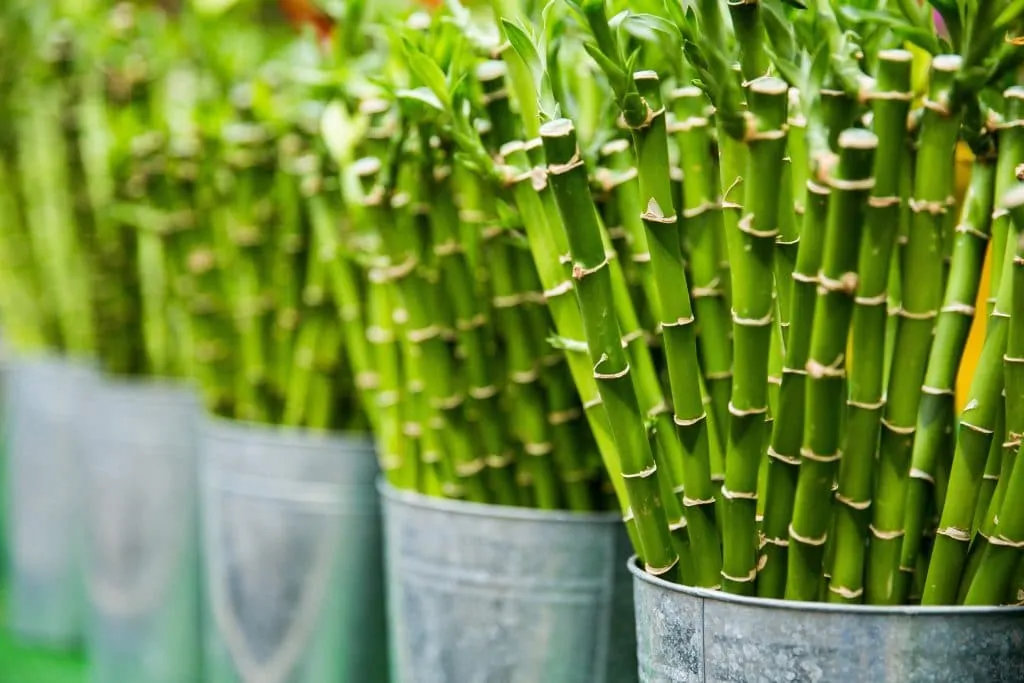
Normally, bamboo growing large is not recommended for indoor gardening and would not be considered among the best houseplants for your bathroom.
However, some bamboo species are more than suitable for indoor planting, such as Chimonobambusa marmorea, a type of bamboo that is very well suited for bathrooms as it grows well in shady conditions.
Some people may prefer not to have soil in the bathroom at all. In that case, having bamboo in your bathroom makes even more sense, as it can be kept directly in water or a bowl of clay pebbles.
A bamboo that is not a real bamboo but is often sold as one is the “lucky bamboo” or Dracaena sanderiana. The lucky bamboo is perfect for the bathroom as it will thrive in low light, will give your bathroom an oriental touch, and will also grow well and can be kept in a bowl of water.
Let’s now look at the different factors such as light, temperature, and humidity and determine how suitable a plant bamboo plant is for the bathroom. We will also highlight some specific types of bamboo by referring to them by their Latin name:
Light: Bamboo generally does not need crazy amounts of light and is, therefore suitable for bathrooms. Some potted bamboo species can grow in moderate and low light. Chimonobambusa marmorea, Pleioblastus viridi-striatus, and Psuedosasa japonica are some species of potted bamboo that can deal with or even thrive in average light levels.
Hibanobambusa tranquillans Shiroshima, with its nice variegation, Indocalamus latifolius an east Asian species of bamboo, and Indocalamus tessellatus, the large-leafed bamboo, will grow in low levels of light.
Temperature: Bamboo is one of the most resilient plants on the planet. While most bamboo species do well in temperate, tropical climates, some types can deal with mountain or desert climates.
There are species in the groups of Phyllostachys and Fargesia that are even cold hardy down to minus 30 degrees Fahrenheit (-1 °C). We hope this describes not your bathroom conditions! But judging from the needed temperature ranges, bamboo will do well in the bathroom.
Humidity: Bamboo is considered to be a humidity-loving plant. You will need a spray bottle or a pebble tray with water to keep the humidity levels around your home’s bamboo plants. In the bathroom, with its increased humidity levels caused by flowing water, these conditions are already present.
Size: There are many different types of bamboo, and the space requirements generally vary. While some bamboo species, such as Dendrocalamus giganteus, can reach a height up to 98 feet (or 3o meters) in its natural environment, the slender look of bamboo, as well as its habit of growing generally higher than wide, is a big benefit. Eventually, the bamboo plant will spread using its underground rhizomes and grow into a clump, which can easily be pruned and kept in check.
Fun Fact: Did you you know that bamboo belongs to some of the fastest growing plants in the world? It can grow 36 in (91 cm) in a 24 hour period at a rate of 1.6 in (4cm) in an hour. You better make sure to check on your bamboo when you are brushing your teeth in the morning.
(Bonus) Water needs: Water is the most important factor for growing bamboo plants. The watering cycle of bamboo is very interesting. When you do not provide enough water, it rolls its leaves to minimize evaporation. When leaves are rolled, provide it with water, and the leaves will unravel again. How is that for a watering level indication?
2. Aloe Vera
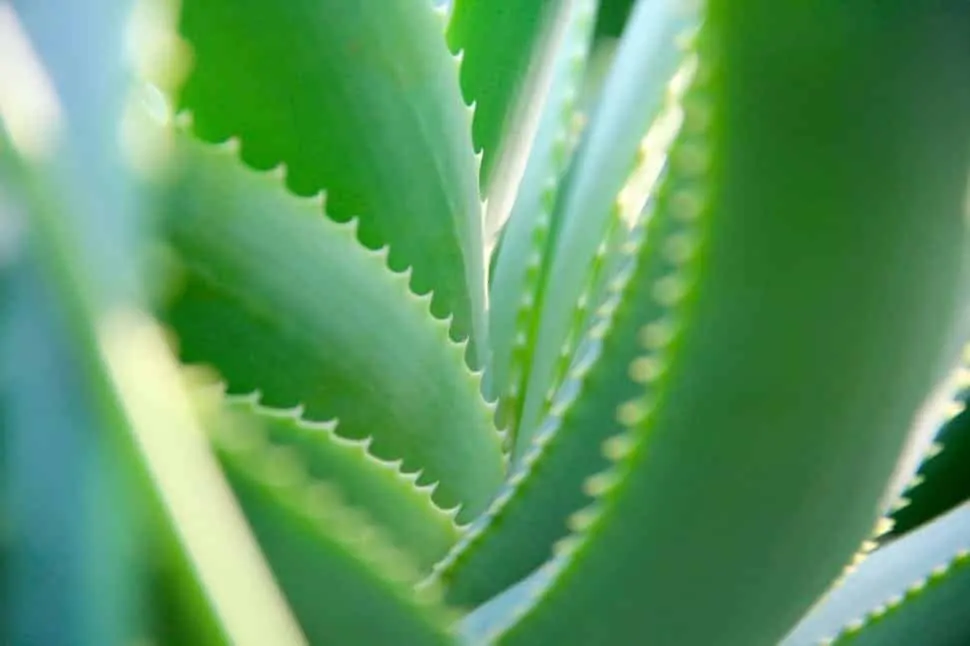
Aloe Vera is valued for its medicinal properties around the world. It is also used for many creams and substances in the beauty space and is a suitable candidate for your bathroom.
It seems to be a natural fit as it is often associated with beauty, youth, and health. Something many of us try to achieve by spending more time in the bathroom. Aloe belongs to the species of succulent plants.
Let’s once again look at how suitable Aloe is and if it is worthy to be in the list of the 12 easiest houseplants for your bathroom:
Light: It does not require high light levels because sunlight exposure can harm Aloe Vera. You will often see brown plants in very hot temperature zones with a lot of direct sunlight.
As ironical as it is, Aloe can get sunburnt despite being used in many sunscreens and after-sun lotions. Because of its low light level requirements, it is highly recommended for the bathroom.
Temperature: Aloe requires minimum temperatures from 30°F to 35°F (-1°C – 10°C) and do best between 55°F to 80°F (12°C – 27°C).
Humidity: The humidity level of the bathroom is usually high, and Aloe Vera can survive this high humidity very easily because it does not require regular water supply for its growth.
Size: Aloe Vera grown in pots does generally not grow bigger than 24 inches (61cm)
(Bonus) Flowering: Although this plant is a well-suited candidate for bathroom and indoor decoration, it should be kept outdoors during hot months to initiate the flowering process.
It shows Gray-green leaves and yellow blooms during the blooming phase. This is hardly achieved indoors, but Aloe Vera looks great throughout the year.
3. Cast-Iron Plant
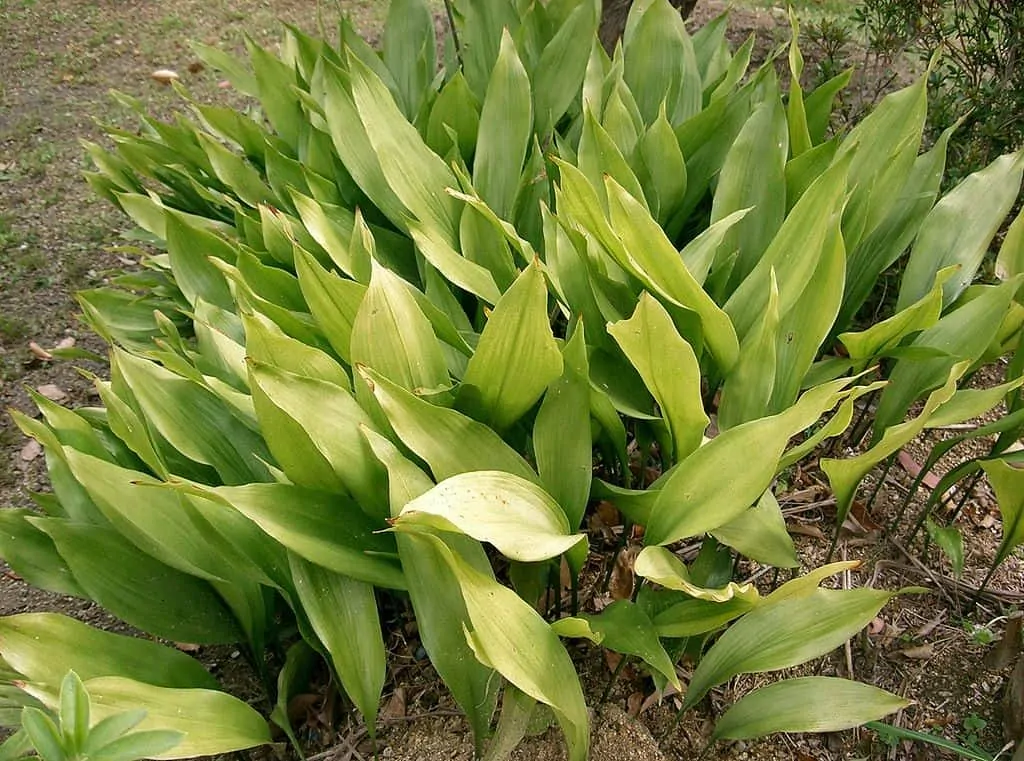
This plant is a strong candidate for the best houseplants for your bathroom greenery award because it can bear harsh light and temperature conditions, grow 2 to feet tall (0.9 m) only, and requires very low maintenance. Aspidistra elatior is called cast-iron plant because it is very hard to kill.
Light: It can bear shady conditions and will do well in bathrooms with very little light. Cast-iron plants do not thrive with too much direct light.
Temperature: It can bear temperatures as low as 23 °F (-5 °C). Guests’ bathrooms are not often used, so these are cold and less humid. It can grow even in these less humid conditions and is considered one of the best candidates for guest bathrooms.
Humidity: They do best with air moisture and do not handle low humidity for an extended time.
Size: Grows up to 47 in tall (1.2m tall).
(Bonus) Soil: Soil conditions for this plant are very easy to handle. A general well-draining potting mix for houseplants is fine.
4. Chinese Evergreen
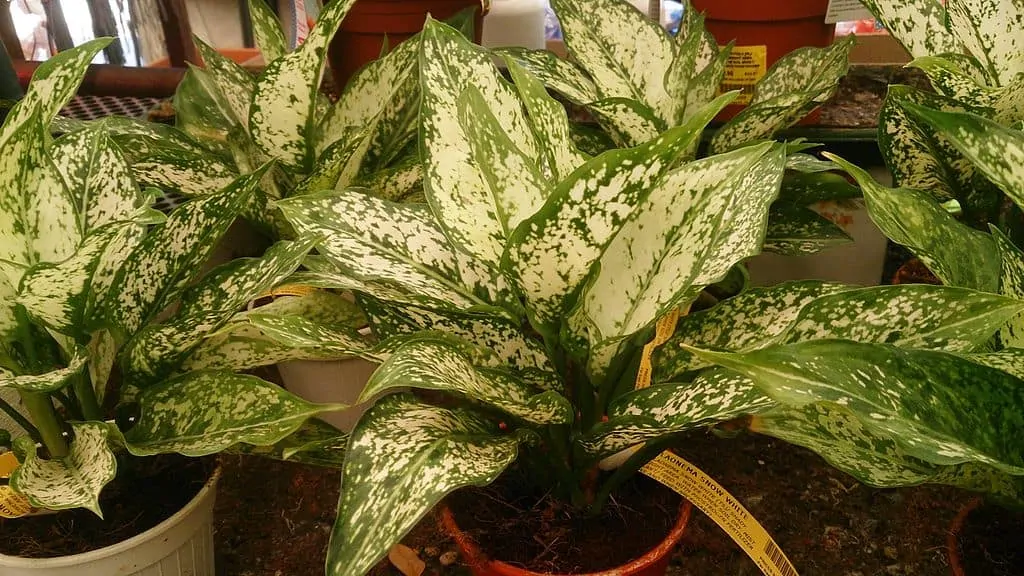
The Arum family has many genera of flowering plants, and the genus Aglaonema is one of them. This genus contains flowering plants which can grow and flourish indoors.
Many species of this genus can grow in bathroom conditions. The common name for these plants is Chinese Evergreens.
Light: Chinese evergreens can cope with lower-level light conditions and should not be put into direct sunlight. Varieties with pinkish colors are better suited for brighter conditions, whereas dar-leafed variants do better in less light.
Temperature: The most suitable temperature range for Chinese Evergreens is 64-77° F (18 to 25°Celsius). Most bathrooms will be in that range.
Humidity: Chinese evergreen plants can bear fluctuations of humidity and can even withstand dry air, which is suboptimal for most houseplants. If they could choose, they would prefer more humid conditions.
Size: Due to its small size (1 to 2 feet), it is also a strong candidate for bathroom plantation. They are not the biggest growers in the indoor jungle, making them perfect for smaller spaces.
(Bonus) Soil requires proper nutrition, and its soil conditions are a bit tricky as you will ensure a soil rich in nutrients. In addition, these plants appreciate well-draining soils that have added perlite and sand.
5. Croton
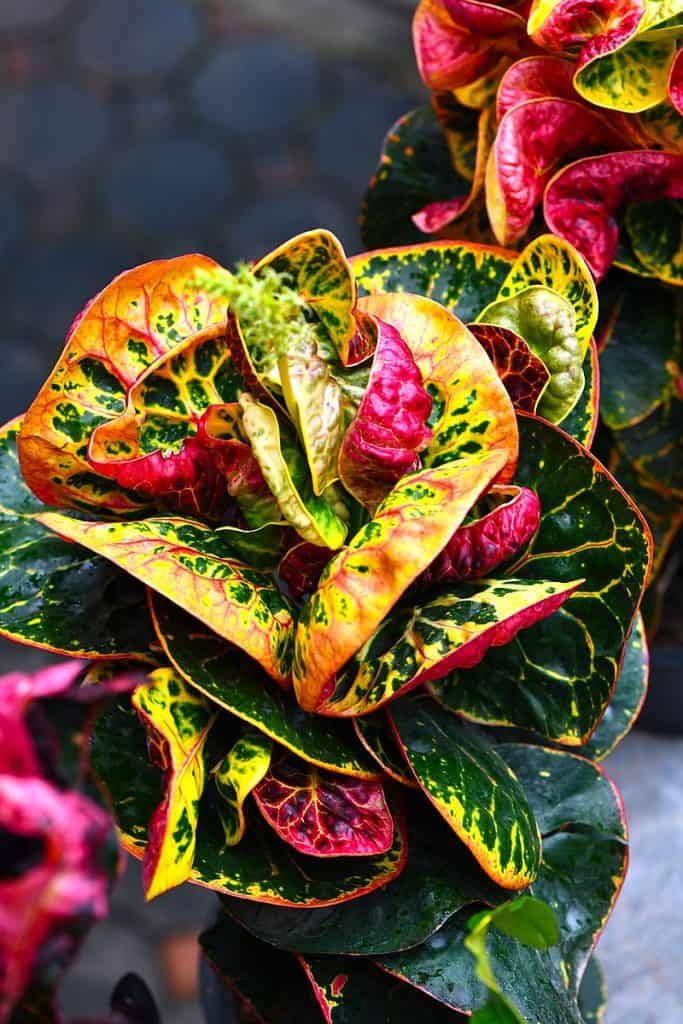
Euphorbiaceae is a spurge family of flowering plants. Croton is one of the genera of this family. It consists of many flowering plants suitable for indoor gardening and, first and foremost, made it into our list of the best houseplants for your bathroom.
These are called croton because the seeds of many plants are tick-shaped. Although gorgeous flowers can grow on these plants, the croton foliage is a show-stopper.
Temperature: A temperature around 75 °F (24 °C) works best, while temperatures between 60 °F (16 °C) are too low. An ideal temperature range for the crotons is between 70°F and 80 °F (21°C and 27 °C).
Light: Light conditions for croton plants are manageable in bathrooms because they require indirect light.
Humidity: These plants love the extra humidity. A humidity level between 40% to 80% is deemed ideal. A humidity level of 70% is considered ideal.
Size: Beware. Big spaces are needed as they can grow up to 6 feet (182cm).
(Bonus) Watering: In general, these plants are very sensitive to watering and need to be watered from daily to weekly depending on the conditions they are in and in what season they are. The watering should be reduced during the fall and winter seasons.
6. Dumb Cane

Dumb canes are considered optimal houseplants for bathrooms because they do not require extensive care, and their foliage is just stunning. Dieffenbachia is the correct botanical name commonly used in the trade.
Generally, dumb canes are easy to care for and can thrive in bathrooms if you provide them with the right care.
Temperature: An average room temperature range between 65 to 75 degrees Fahrenheit (18 – 24 °C) is perfect. Once the temperature goes below 60 degrees Fahrenheit, these plants may show yellowing on leaves and quickly deteriorate. So, as long as your bathroom is heated throughout the year, you are safe. Not the best guest-bathroom plant.
Light: Light conditions of these plants can vary, and these generally require bright light when days become shorter (during the winter season). During warm months, the supply of light should be lowered. Regular rotation of the plants should also be practiced to maintain the plant’s greenery to form on each side.
Humidity: They are big fans of rather high humidity, making them perfect bathroom plants. However, they would also adjust to less-than-optimal conditions.
Size: One of the major hurdles to growing Diffenbachias is that these can grow up to several feet and require big bathroom spaces. This is not the right plant if your bathroom is tiny and squeezy.
(Bonus) Watering: These plants do not require regular watering and flourish happily at a low water supply.
7. Gardenias

The most important indoor plant of the Gardenia genus is G. jasminoides which is also well-known by its trivial name, cape jasmine. These plants are tricky to grow in bathrooms because they require extensive care.
However, we still consider it a great fit for bathrooms as it is an evergreen flowering plant with scented blossoms from the coffee family that is just beautiful to look at.
Fun fact: They are also often used as bedroom plants and are said to work as well as valiums to promote sleep and relieve anxiety.
Temperature: These plants cannot bear fluctuations in temperature icy conditions and sudden heat blasts.
Light: Gardenias need several hours of sunshine per day to thrive. This is one of the plants that thrives in bright light but not in direct sunshine when kept in containers.
If you live in a rather hot area, direct morning sun and light afternoon shade are best. In bathroom conditions, we recommend at least 6-8 hours of sunshine. Therefore, the perfect place for these plants is the windowsill of a rather bright window.
Humidity: Gardenias are well suited to grow in bathrooms as they require high humidity to grow well and feel at home.
Size: These plants can grow up to 6 feet (1.8m), but pruning at regular intervals can keep the plants smaller.
(Bonus) Fertilizers: These plants usually require acidic conditions, and acidic fertilizers should be used.
(Bonus) Flowers: The white flowers of these plants are the main attraction for ornamentals.
8. Orchids

The family Orchidaceae comprises many genera that produce beautiful flowers. These plants are collectively known as orchids. Many orchids are suitable for bathroom conditions as they love heavy, humid spaces. Some common species are Phalaenopsis (Moth Orchid), Orchis mascula (Early purple orchid), Anacamptis morio (Green-winged orchid), and Aplectrum hyemale (Adam and Eve orchid).
Temperature: 80°F ( 27°C) is the perfect temperature for orchids. But orchids grow well in a range between 65°F – 80°F (18°C – 27°C).
Light: Orchids usually grow in moderate light, but some specific species need bright light for their growth and flowers to bloom.
Humidity: Many species of orchid belong to epiphytes. Epiphytes are plants that absorb moisture from the humid air. Therefore, the bathroom is a perfect environment for our beloved orchids.
Size: Due to their small sizes, orchids are strong candidates for bathrooms and only take little room.
(Bonus) Flowers: These produce flowers of different colours such as purple, pink, and white, and many more, depending on the nature of the species.
9. Peace Lilies
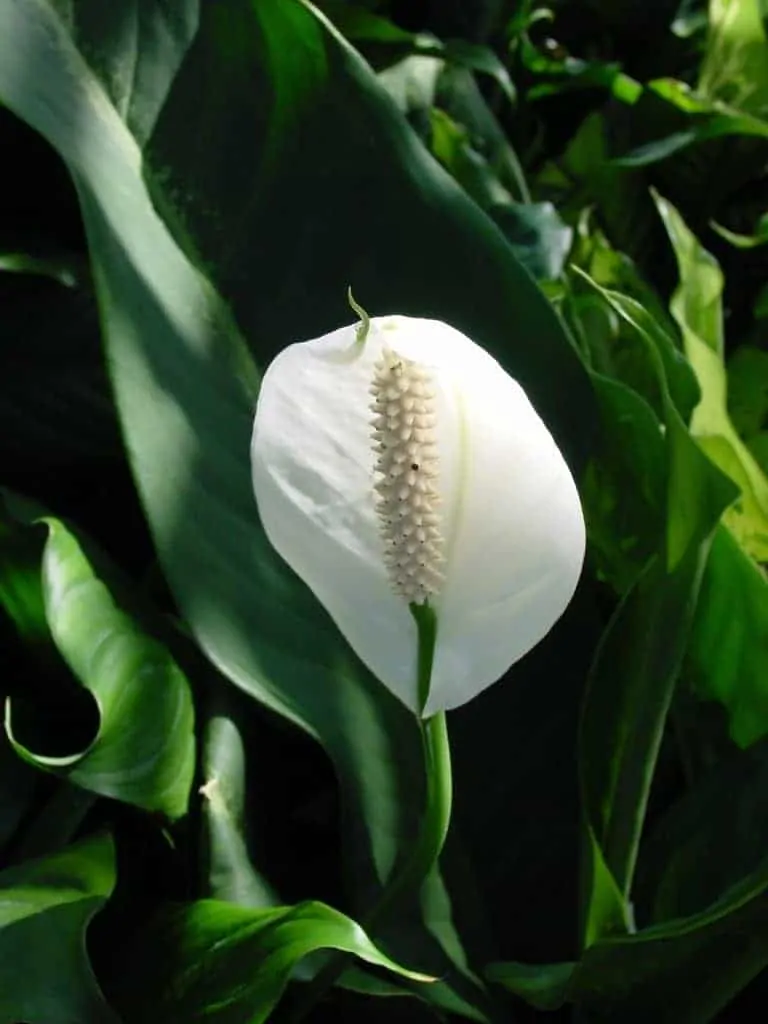
Spathiphyllum is a member of the Araceae family. It is appreciated for its beautiful flowers and is considered a common houseplant. About 40 species are present in the Spathiphyllum genus, commonly called peace lilies. This species does not require extensive care and can flourish with minimal effort. Peace lilies are a favorite among houseplant enthusiasts and made it into our list.
However, one thing needs to be said. They are huge drama queens/kings. These plants will make a huge show if you forget to water them once. Everything will start to hang and look very sloppy.
But don’t worry. Once you give them a good soak, they will quickly recover.
Temperature: Peace Lilies grow best in a temperature range between 68°F to 85F (20°C – 29°C). At night, the temperatures are allowed to decrease by 10°F. Since this is a temperature range most humans will feel at home, it is no wonder these plants are so well suited for homes.
Light: Peace lilies can flourish in lower light, but the bloom of flowers may require brighter light. It is also known that Peace lilies do astonishingly well with just fluorescent light.
This is also why you will likely find them planted in your favorite shopping mall.
Humidity: High humidity levels in the bathroom are good for their growth.
Size: The sizes of Peace Lilies reach 16 inches to 6 feet (40-182cm) as there are many different types of Spathiphyllum.
(Bonus) Watering: Peace lily is probably the plant with the biggest water need ever. Like most plants, they do not like to have wet feet and stay in wet soil for too long. On the other hand, they will need frequent watering and are great “drinkers”.
(Bonus) Flowers: Peace lilies are the source of attraction because of their beautiful white flowers. The chance of having flowers can be increased by increasing the light the lilies get.
10. Asparagus fern
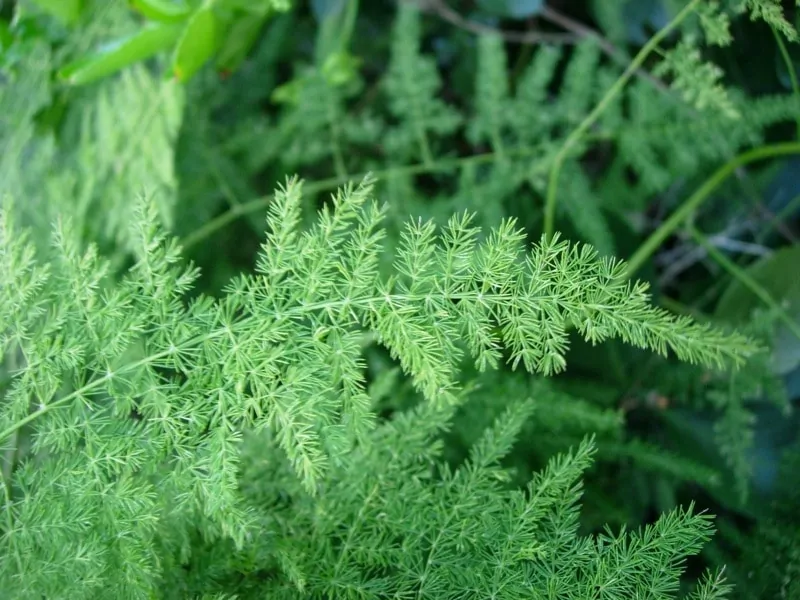
The Asparagus Fern is a very nice houseplant with its light and beautiful foliage.
Although not as common as many other plants described in this list, it is well-suited for bathroom conditions due to its limited light requirements and the need for warm temperatures.
Temperature: These ferns prefer warm temperatures and will not tolerate temperature swings at 50°F (10°C). Therefore, they are more suited for a bathroom that is kept warm all year round.
Light: It requires only moderate light but can also take bright light as long as it is indirect.
Humidity: Asparagus ferns do not like dry air. They need humidity. Mist daily and provide a pebble tray if kept in any room that is not the bathroom.
Size: These plants can grow up to 2 feet high (60cm).
(Bonus) Watering: A strict watering regiment is to be kept. They do not like to dry out. Weekly or even more frequent watering is needed to keep these ferns happy.
(Bonus) Growth: Asparagus fern does not require repotting regularly and can spend up to 2 years in the same pot.
11. Philodendrons

The Araceae family contains many genera of flowering plants, and Philodendron is one of them. In September 2015, 489 species have been categorized in this genera.
Many species can grow in bathrooms as they thrive in a more humid environment. Philodendrons grow better with less care and are considered strong candidates for bathroom house plants.
Temperature: Temperature needs vary within the group, but it can be generalized that none of the Philodendrons likes to be below 50°F (10°C) for an extended time.
Light: Light levels should be maintained according to the Philodendron species as needed light levels vary. An absence of light and long-term shade will turn stems spindly. However, if we generalize the needed light levels, bright indirect light will suit most Philodendron.
Humidity: Philodendrons are humidity lovers. This is one main reason why they are the perfect bathroom plants.
Size: These plants can grow up to 20 feet. Some types are vining, whereas other Philodendron types are called self-headed, developing multiple individual heads as they grow.
The self-headed types make great foliage plants that can be put on tables or floors. On the other hand, you have the vining types of Philodendron that can either climb or hang.
(Bonus) Watering: The watering cycle of the plant should be managed properly because plants will shed their leaves when too little or too much water is provided.
12. Cyclamen
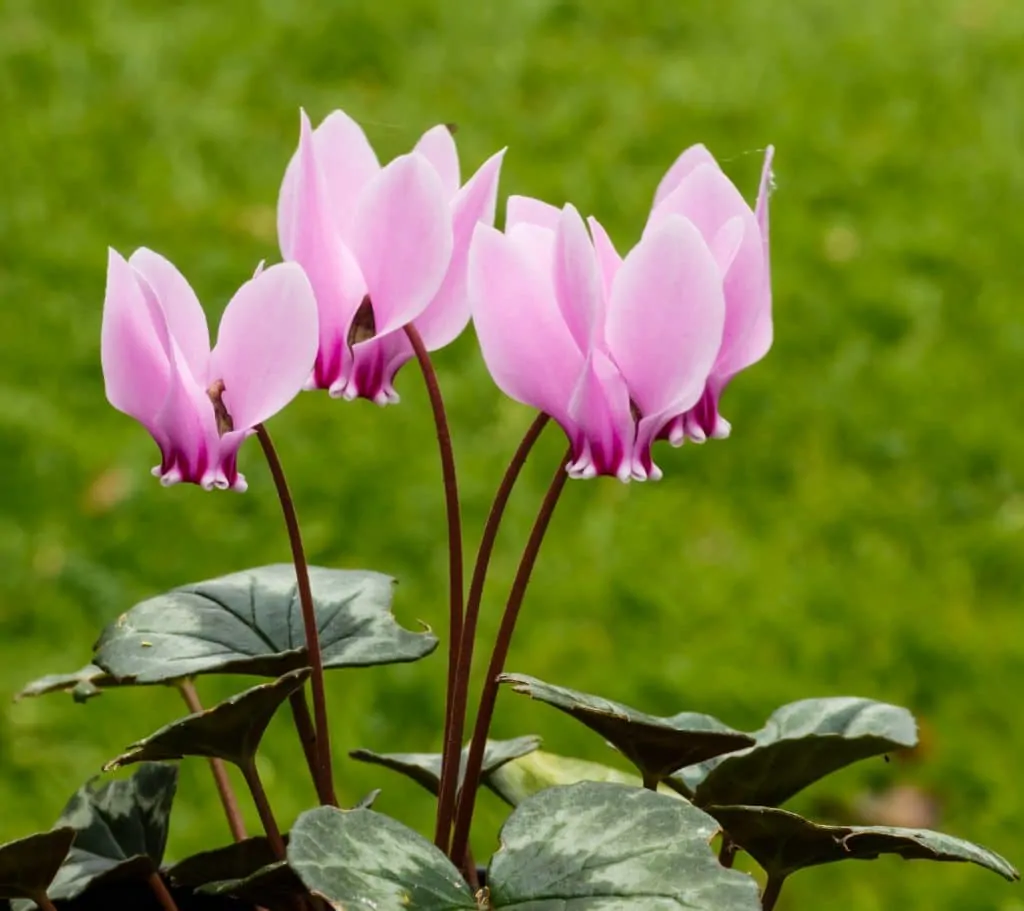
C. persicum is the most common indoor plant from the Cyclamen genus. It is a small flowering pot plant. The trivial or common name of this species is the Florist’s cyclamen.
These are beautiful plants that have colorful blooms and are also blooming during wintertime. They also have attractive leaves and bloom readily.
They are a little bit more tricky to grow in bathroom conditions but make a great bathroom plant when provided with proper care.
Temperature: Cyclamen requires rather cool temperatures between 50°F and 65°F (10°C-18°C). This way, their flowers will last much longer compared to higher temperatures. It is, therefore, the ideal plant to be kept in a guest bathroom where the central heating might not always be on.
Light: During their bloom period, in the winter, these require high-intensity of indirect light.
Humidity: They prefer a good amount of humidity. When not kept in humid conditions, a pebble tray filled with water underneath the pot might do the trick.
Size: The Cyclamen plants are not more than 9 inches, making them an attractive candidate for bathrooms with generally limited space available.
(Bonus) Watering: Regular and thorough watering is required. The best way to water them is from the bottom, not the top, where the water might touch the leaves.
(Bonus) Flowers: These plants are a major source of attraction due to various flower colors, such as purple, pink, violet, and white, depending upon the plant type.
Bathroom Conditions Relevant For Plants
Plants that can grow happily in bathrooms need to be fine with various levels of light, sudden temperature, and humidity changes in most cases. Bathrooms become cold when they are not being used for a long period, but the use of hot water during baths and showers can suddenly lead to an increase in temperature.
These practices can elevate the humidity level of bathrooms as well.
When thinking about what plants to put into bathrooms, you should be looking at the needs of your houseplants in the following categories, as they are crucial to determining who makes it into the list of the easiest houseplants for your bathroom:
- Light
- Temperature
- Humidity
- Space
Light
Light is one of the basic requirements for plant growth. Some plants can flourish in dim light and are considered suited for bathroom conditions. But these plants also require plenty of light during their specific growth periods. For providing light to these plants, fluorescent bulbs are usually recommended because these bulbs contain specific wavelengths that are beneficial for growth in plants.
To be very blunt. No plant can grow without any light source. Every plant needs light, be it artificial or sunlight. The ZZ plant has been fine for several months with little to no light. However, low light levels will decrease growth and kill your houseplant sooner or later. Depending on the plant, this can take days, weeks, or even months, in the case of the ZZ plant.
Temperature
After the light, the next main factor for the growth of plants is temperature. Although the optimum temperature for growth varies between plants, the normal temperature for the growth of indoor plants, and especially for bathroom houseplants, is between ~70 °F (21 °C) to ~ 80 °F (26.5 °C) during the day and ~65 ° F (18 ° C ) to ~70 ° F (21 ° C) at night.
While most plants do fine in these conditions, some plants might have difficulties with the mentioned temperature swings or require different day and night temperatures or more constant temperature drops or increases to thrive in the long term.
For example, the moth orchid, aka Phalaenopsis, needs a temperature drop of about 10 degrees to produce flowers. This may be achieved in a bathroom with windows by placing the orchid directly in front of a window.
On the other hand, a bathroom without a window may not be able to reproduce the constant temperature swings needed. It may also not be suitable as Phalaenopsis requires bright indirect light, although Orchids are generally a suitable plant for bathrooms if that makes sense.
Humidity
Humidity levels also impact plant growth, often considered an important factor during early plant life. Humidity levels in bathrooms are often high because of frequent water flow.
Usually, plants that love to grow in high humidity levels are recommended in bathrooms.
So it is better to put a Monstera Deliciosa or Monstera Adansonii into a bathroom or any Philodendron for that purpose before you think about moving your cactus to a new location. Some plants won’t appreciate the extra humidity.
Space
Regarding space, bathrooms often have limited room for decoration and, most importantly, houseplants. Usually sized leafy friends are not recommended for bathrooms.
Plants that hang from the ceiling and have small growth sizes are usually the best option if they can bear the above-described conditions in many bathrooms.
An option for larger plants that may not be in the bathroom at all times would be to move them from time to time to the bathroom so you can either have them have a shower or at least profit from the humidity created by flowing water after someone had a shower.
You wouldn’t be the first person to do that.
Plants for a Bathroom with no Window
The following plants are recommended for bathrooms with no windows:
- Lucky Bamboo
- Aloe Vera
- Chinese Evergreen
These plants do grow fine under fluorescent light. Of course, they would thrive more if they were close to a window. But not every bathroom has a window, and some houseplants grow well without natural light.
Final Words
After reading this article, you have a good idea of adding green and color to your bathroom.
As many of the plants described thrive in humid and rather warm temperatures, bathrooms can be an ideal home. The light in your bathroom must be considered the most crucial aspect.
Little light is fine for some plants, while many require at least bright indirect light. Some plants will deal well with fluorescent light, while others may require at least a small window to be happy.
With the list of the 12 easiest houseplants for your bathroom, you should have a good idea by now of how you will decorate one of the most important rooms of your home. Have fun and happy indoor gardening.

Daniel has been a plant enthusiast for over 20 years. He owns hundreds of houseplants and prepares for the chili growing seasons yearly with great anticipation. His favorite plants are plant species in the Araceae family, such as Monstera, Philodendron, and Anthurium. He also loves gardening and is growing hot peppers, tomatoes, and many more vegetables.

